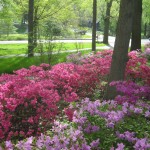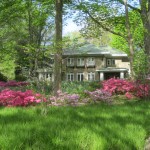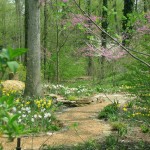Written by Scott Lumpkin
A wooded lot is an attractive feature for many prospective home buyers, and those who currently live on wooded sites know the value of the privacy it affords and the beauty of the changing colors of the trees each fall. But more often than not these areas are simply left as they are and viewed from afar. While the natural beauty and function of woods is great, these areas are actually ripe for improvement. Woodland gardens are an opportunity to take an underused area and transform it just as you would any other outdoor space. 
While these sites do have some limitations, they present some interesting opportunities as well. Groupings of mature trees create a latent sense of enclosure with natural pathways and unique viewsheds. Dappled sunlight through the foliage adds to the atmosphere. Unexpected clearings can provide relief from crowded surroundings and a splash of sunlight from above. However, sometimes there needs to be some human intervention to shape the spaces to fit our needs. Many times unmaintained wooded areas are severely overgrown and in need of thinning and clearing to create the right environment. In this case, careful selection of the valued specimens from the weed trees is essential. It’s important to limit the clearing to modify the site for your best use while still maintaining the natural beauty that we love. Other sites may be especially barren from the forest floor to the canopy, and in need of vegetation at the human level. For these areas an informed selection of plant material is needed.
While most plants thrive on both sunlight and water, many plants have adapted to fit the shady conditions of the woodland understory. As anyone familiar with the Masters golf tournament knows, there is nothing quite like the springtime floral display of azaleas and dogwoods in a wooded setting. These plants are particularly suited to the woods edge where they have a mix of shade and sunlight and are particularly attractive against a wooded backdrop. In western Pennsylvania, the Frank Lloyd Wright designed Fallingwater is recognized as one of the great works of residential architecture in the world. Those familiar with the home know the importance of the woodland garden to the building itself, filled with beautiful white and light pink blooming rhododendrons perfectly suited to that ecosystem. Another useful and interesting woody shrub for this environment is Vernal Witchhazel (Hamamelis vernalis), which produces a very interesting and very early season bloom, before the overhead canopy has yet to reappear.
Perennial plants that appear across the forest floor are what really add life to a woodland garden. Two familiar and popular plants perfect for this application are hostas and ferns. They are attractive, reliable, provide great textural interest, and are available in a vast number of varieties with various colors and sizes. Other perennials for these sites that are native to the habitat of the deciduous forest of Indiana are columbine, Solomon’s seal, and wild ginger, which can form a mat of glossy green foliage across the forest floor.
If you are fortunate to live in a naturally wooded setting think about how you could get even greater value and enjoyment from your surroundings by creating a woodland garden. The creative and knowledgeable staff at Mark M. Holeman, Inc. can work with you to develop a beautiful and well-designed woodland garden that creates a unique outdoor space from an overlooked part of the landscape.


